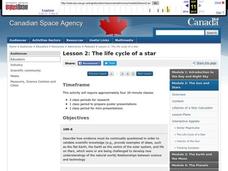Curated Video
NASA’s Incredible Discovery Machine: The Story of the Hubble Space Telescope
Hubble's launch and deployment in April 1990 marked the most significant advance in astronomy since Galileo's telescope. Thanks to five servicing missions and more than 30 years of operation, our view of the universe and our place within...
Curated Video
What's Stopping the James Webb Space Telescope?
The James Webb Space Telescope is the most complex telescope we’ve ever sent into space. But, Webb is not, in fact, in space… yet.
Curated Video
New Hubble Video Miniseries Goes Behind the Scenes of Our 'Eye in the Sky'
A new video miniseries explores the intricate world of operating the Hubble Space Telescope. In Hubble – Eye in the Sky, viewers get an inside look at the challenges of operating the telescope, along with an understanding of the...
Curated Video
NASA's Nancy Grace Roman Space Telescope: Broadening Our Cosmic Horizons
Scheduled to launch in the mid-2020s, the Nancy Grace Roman Space Telescope, formerly known as WFIRST, will function as Hubble’s wide-eyed cousin. While just as sensitive as Hubble's cameras, the Roman Space Telescope's 300-megapixel...
Curated Video
Hubble Technology Finds Earthly Applications
The decades-long career of NASA's Hubble Space Telescope has resulted in a wealth of new technologies, many of which have found earthly applications. Learn more about the specific technologies mentioned in this video:Dead Sea Scrolls -...
TED Talks
TED: A stellar history of modern astronomy | Emily Levesque
Astronomers once gazed upon the night sky and counted every star in the galaxy by hand. The process has evolved since then, but the thirst for celestial knowledge remains the same. Join astrophysicist Emily Levesque for an anecdote-rich...
Curated Video
Time-Lapse Tilting of Webb Telescope's Primary Mirror
The 18-segment primary mirror of NASA's James Webb Space Telescope was raised into vertical alignment in the largest clean room at the agency's Goddard Space Flight Center in Greenbelt, Maryland, on May 4, 2016. The James Webb Space...
Curated Video
WFIRST Will See the Big Picture of the Universe
Scheduled to launch in the mid-2020s, the Wide Field Infrared Survey Telescope (WFIRST) will function as Hubble’s wide-eyed cousin. While just as sensitive as Hubble's cameras, WFIRST's 300-megapixel Wide Field Instrument will image a...
Curated Video
The Technology to Get us to Space
Dr. Forrester examines the technological innovations in the study of space by giving examples of innovations which have led to advances in space programs. She also identifies space travel programs by exploring NASA and the efforts that...
Curated OER
Hubble Space Telescope Webquest
Students research the Hubble Space Telescope. In this Hubble Space Telescope lesson, students complete a webquest about the Hubble Space Telescope.
Curated OER
The Life Cycle of a Star
Students investigate the life cycle of a star and make conclusions based on evidence, research, and observation. For this lesson on space and scientific investigation, students describe the relationships between science and technology...
Curated OER
SETI WebQuest and the Drake Equation
Students complete a WebQuest where they research the Internet for extraterrestrial intelligence. In this extraterrestrial lesson plan, students also explore how the Drake Equation can predict the occurrence of life elsewhere.
Curated OER
The Next Logical Step in Astronomy
Students research future astronomy endeavors and how the exploration with contribute to astronomy and humanity. In this astronomy lesson plan, students research, present, and debate the topics as a class.






